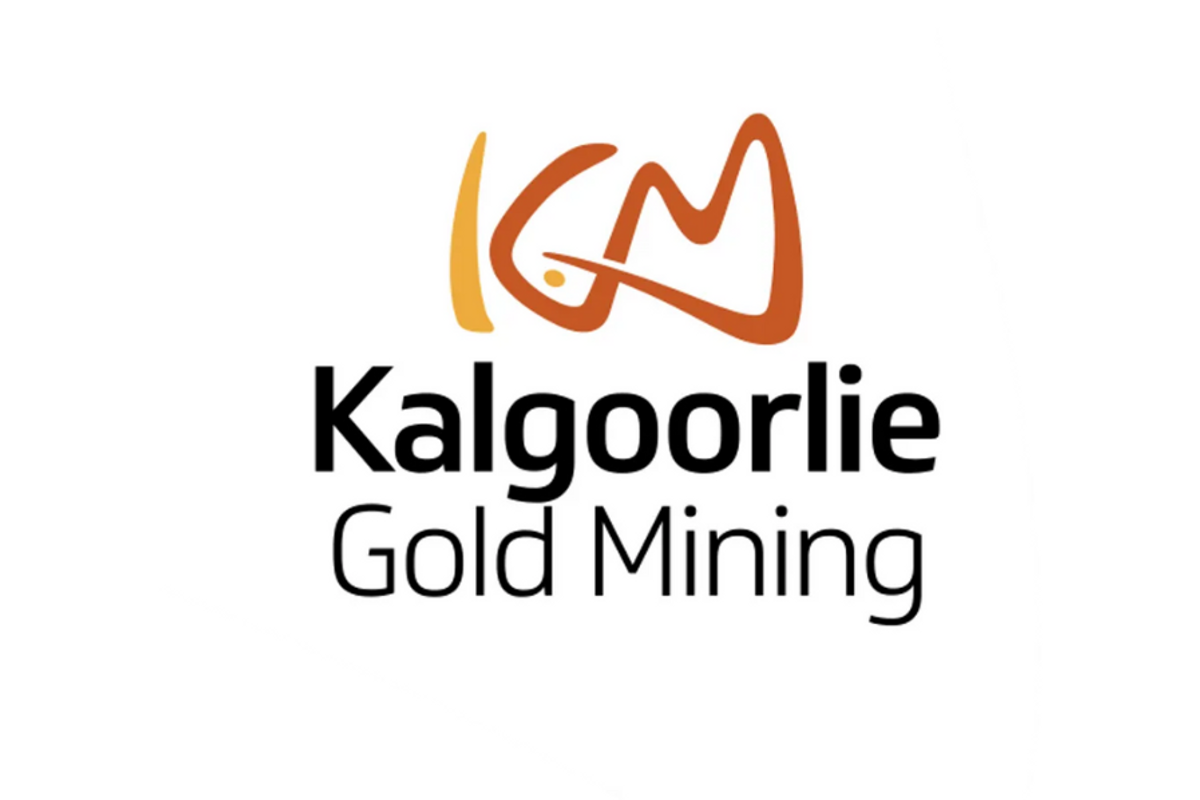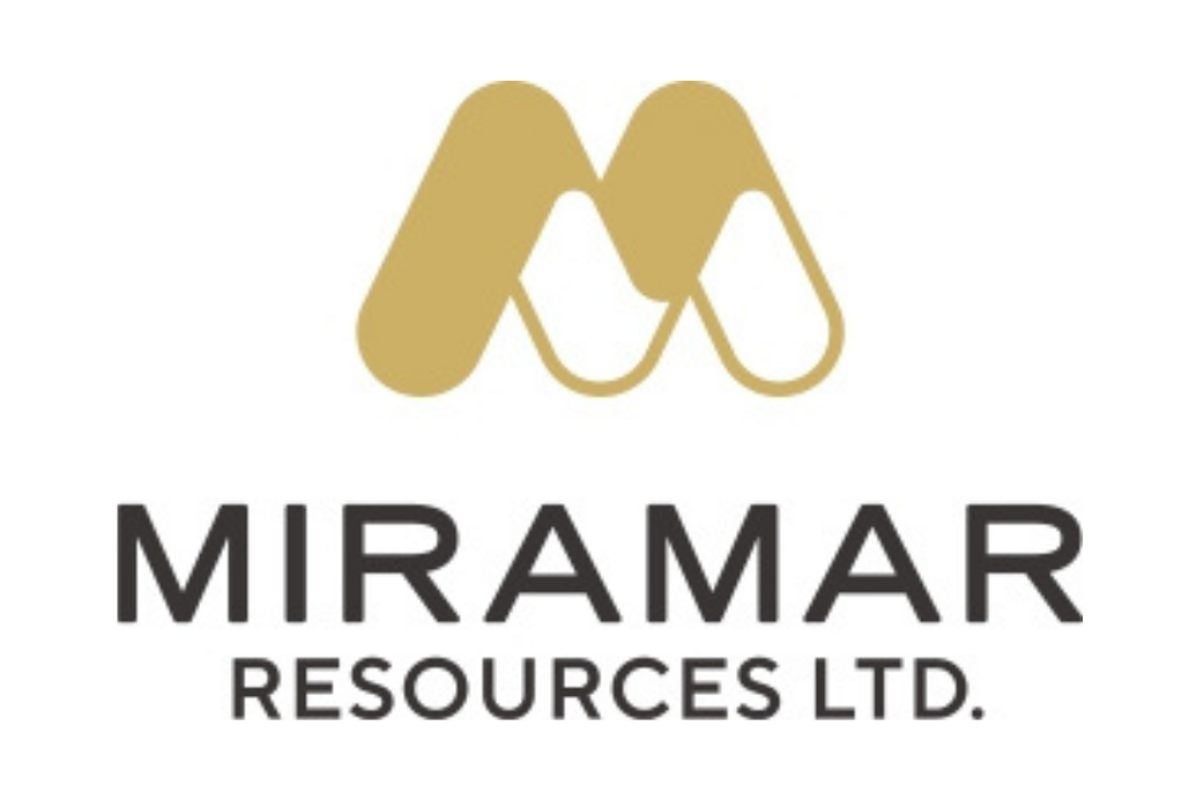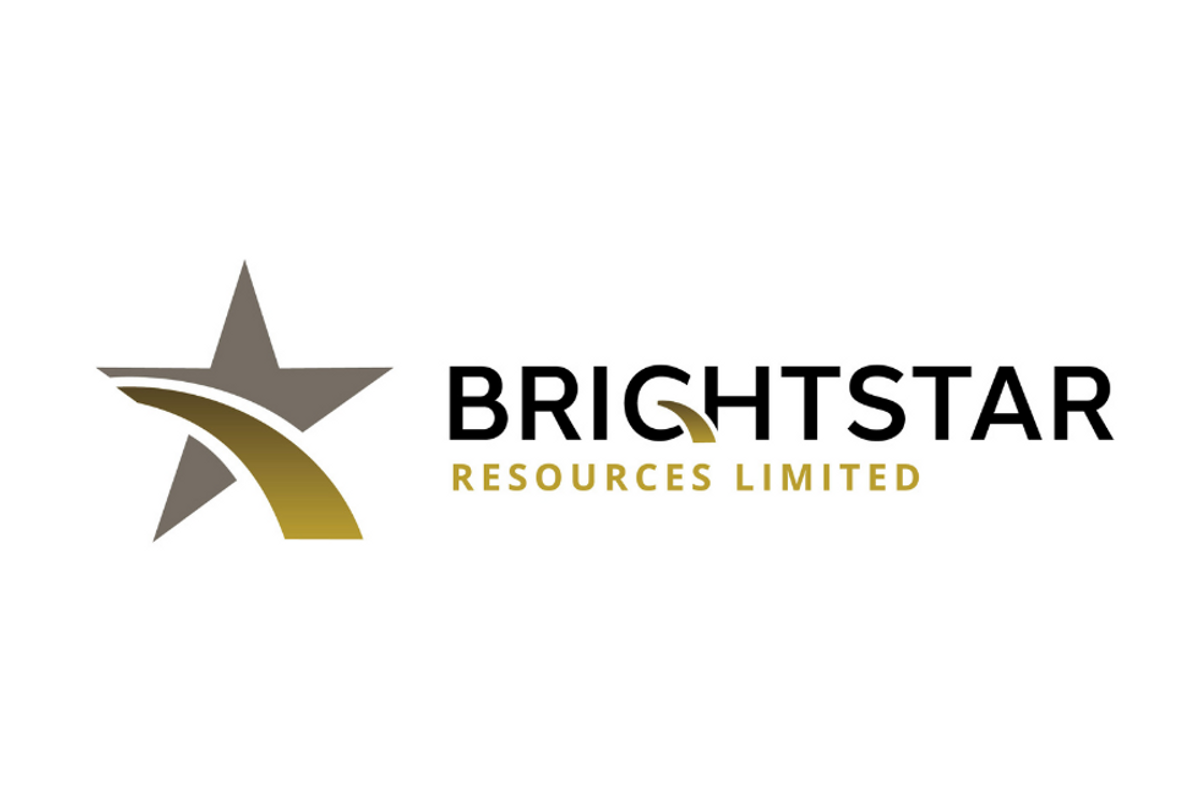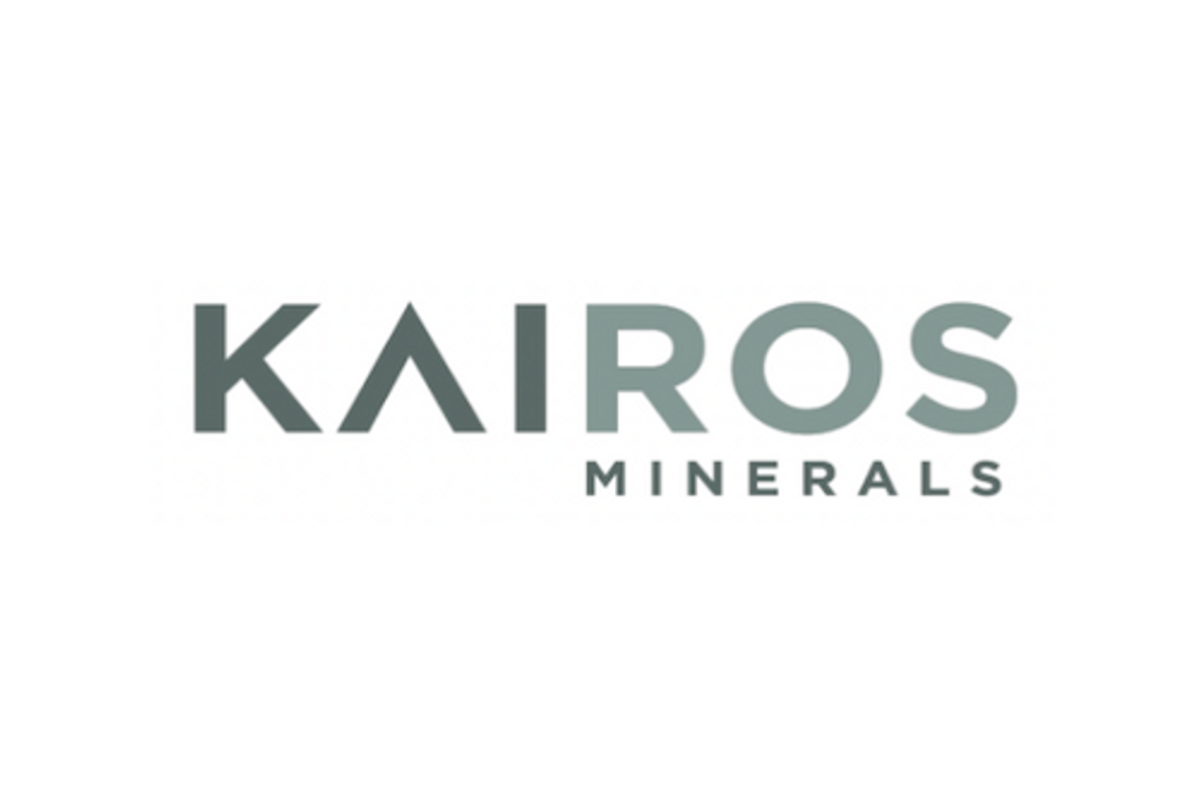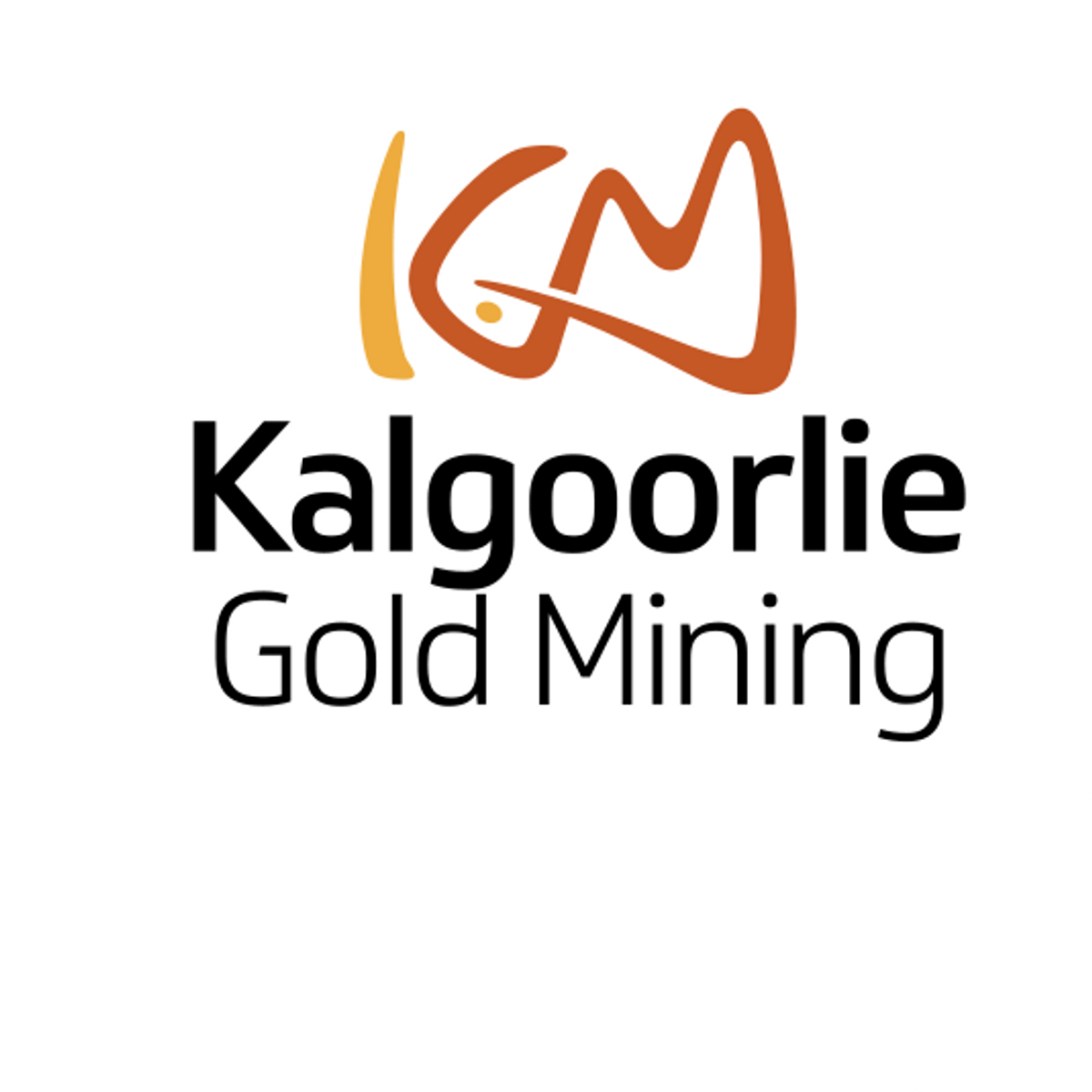
June 02, 2025
Kalgoorlie Gold Mining (ASX:KAL) is a technically focused gold explorer targeting large-scale, multi-million-ounce gold systems in the Eastern Goldfields of Western Australia. The company employs a modern, methodical approach—combining geophysical interpretation, structural analysis, geochemistry, and systematic aircore and RC drilling—to uncover gold deposits concealed beneath shallow cover in historically overlooked terranes.
Central to this strategy is the flagship Pinjin Project, situated along the underexplored southern extension of the prolific Laverton Tectonic Zone, which has produced over 30 million ounces of gold from world-class operations such as Sunrise Dam, Granny Smith, and Wallaby. Located just 20 km north of Ramelius Resources’ Rebecca Gold Project, Pinjin occupies a highly prospective but underexplored district.
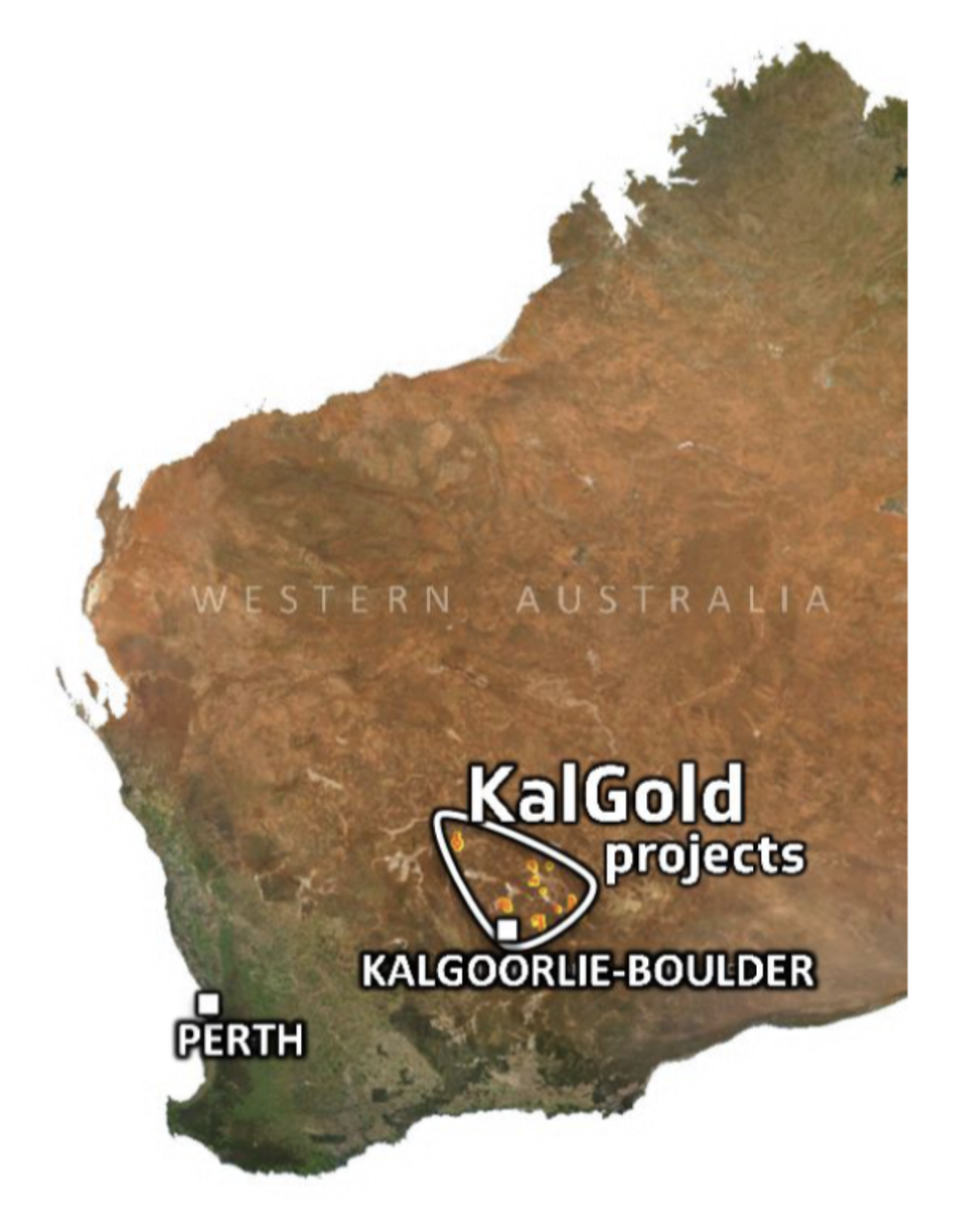
Kalgoorlie Gold has already defined a maiden JORC 2012 Inferred Resource of 76,400 ounces (2.34 Mt @ 1.0 g/t Au) at the Kirgella Gift and Providence prospects. These results confirm shallow mineralization and validate the company’s exploration model. Numerous high-priority structural targets remain untested across the broader project area, offering significant discovery potential.
Company Highlights
- District-scale Positioning: Kalgoorlie Gold controls an expansive, underexplored land package in the Laverton Tectonic Zone, south of major operations like Sunrise Dam and Wallaby and just 20 km north of the planned Rebecca gold mine.
- Lighthorse Discovery: Thick, high-grade gold intercepts under shallow cover confirm a significant greenfields discovery, with potential for resource definition and scale.
- JORC Resource Established at Pinjin: An initial 76,400 oz gold resource at Kirgella Gift and Providence validates the company’s targeting strategy.
- Systematic Exploration Success: >10 targets tested, ~50 percent hit rate with anomalous high-grade gold. Over 90 percent of the company’s target inventory remains untested.
- Experienced Leadership: Matt Painter, managing director, brings deep structural geology expertise and a strong history of generating successful exploration targets globally.
- Favorable Market Tailwinds: With gold trading near all-time highs, Kalgoorlie Gold offers leveraged upside through discovery-driven valuation re-rates.
This Kalgoorlie Gold Mining profile is part of a paid investor education campaign.*
Click here to connect with Kalgoorlie Gold Mining (ASX:KAL) to receive an Investor Presentation
KAL:AU

Sign up to get your FREE
Kalgoorlie Gold Mining Investor Kit
and hear about exciting investment opportunities.
- Corporate info
- Insights
- Growth strategies
- Upcoming projects
GET YOUR FREE INVESTOR KIT
The Conversation (0)
30 May
Kalgoorlie Gold Mining
Investor Insight
Kalgoorlie Gold Mining offers investors a compelling proposition through its strategic focus on low-cost gold exploration in Western Australia's prolific Eastern Goldfields, highlighted by its Lighthorse high-grade gold discovery at the Pinjin project.
Overview
Kalgoorlie Gold Mining (ASX:KAL) is a technically driven explorer targeting multi-million-ounce gold systems in the Eastern Goldfields of Western Australia. Through rigorous geophysical interpretation, structural targeting, and systematic drilling, the company is applying modern techniques to historically overlooked terranes. Its focus is on discovering concealed gold deposits beneath shallow cover by leveraging a proven methodology that includes geophysical analysis, geochemistry, aircore reconnaissance and RC follow-up drilling.
At the heart of this strategy is the flagship Pinjin project, located along the underexplored southern extension of the Laverton Tectonic Zone, a prolific gold-bearing structure responsible for over 30 Moz of historical production from mines such as Sunrise Dam, Granny Smith and Wallaby. Positioned just 20 km north of Ramelius Resources’ Rebecca gold project, Pinjin is ideally situated in a district that has seen limited modern exploration. Kalgoorlie Gold has already delivered a maiden JORC 2012 inferred resource of 76,400 oz (2.34 Mt @ 1.0 g/t gold) at the Kirgella Gift and Providence prospects. These results confirm the presence of shallow mineralization and validate the company’s targeting model. Numerous structural targets have been identified throughout the project area, the majority of which remain untested.

Within Pinjin, the Light Horse Discovery is the company's highest-impact target, where RC drilling has confirmed thick, high-grade mineralization in altered mafic volcanics. The discovery validates Kalgoorlie Gold’s undercover targeting model and is being advanced toward a maiden resource.
Complementing this is the Bulong Taurus project, 35 km east of Kalgoorlie, which hosts the La Mascotte deposit with a JORC inferred resource of 138,000 oz gold (3.61 Mt @ 1.19 g/t). The project includes historic workings and satellite prospects within a structurally favorable corridor. While a secondary focus, heritage approvals are underway to enable follow-up drilling and assess near-term development potential.
To date, Kalgoorlie Gold has tested only around 10 percent of its known targets but has already encountered mineralization in roughly half of them – an exceptional hit rate that underscores the strength of its approach. As the company ramps up its exploration programs, it is positioning itself as one of the most compelling early-stage gold discovery stories in the Australian market.
Company Highlights
- District-scale Positioning: Kalgoorlie Gold controls an expansive, underexplored land package in the Laverton Tectonic Zone, south of major operations like Sunrise Dam and Wallaby and just 20 km north of the planned Rebecca gold mine.
- Lighthorse Discovery: Thick, high-grade gold intercepts under shallow cover confirm a significant greenfields discovery, with potential for resource definition and scale.
- JORC Resource Established at Pinjin: An initial 76,400 oz gold resource at Kirgella Gift and Providence validates the company’s targeting strategy.
- Systematic Exploration Success: >10 targets tested, ~50 percent hit rate with anomalous high-grade gold. Over 90 percent of the company’s target inventory remains untested.
- Experienced Leadership: Matt Painter, managing director, brings deep structural geology expertise and a strong history of generating successful exploration targets globally.
- Favorable Market Tailwinds: With gold trading near all-time highs, Kalgoorlie Gold offers leveraged upside through discovery-driven valuation re-rates.
Key Projects
Pinjin Project

The Pinjin project covers more than 350 sq km and is situated within the southern extension of the Laverton Tectonic Zone, a crustal-scale shear corridor accounting for >30 Moz of historical production. Despite its proximity to major mines, this southern area has seen minimal modern exploration.
Kalgoorlie Gold’s initial focus has been the Kirgella Gift and Providence prospects, where the company defined a JORC 2012 inferred resource of 2.34 Mt @ 1.0 g/t Au for 76,400oz. This estimate was derived from near-surface RC drilling down to ~100 metres, with mineralization remaining open at depth and along strike.
The company has also acquired geophysical datasets and conducted interpretation work to identify additional structural corridors and dilation zones likely to host mineralization. These were validated by soil sampling, structural mapping and aircore drilling. Work completed to date includes more than 16,000 metres of drilling, extensive geological mapping, and data reinterpretation, while upcoming plans involve deeper drilling, geophysics to enhance target definition, and continued aircore programs to expand the exploration footprint.
Lighthorse Discovery

The Lighthorse prospect, situated within the greater Pinjin project area, represents Kalgoorlie Gold’s most promising greenfields discovery to date. Discovered beneath shallow cover using the company's rigorous targeting methodology, Light Horse has yielded multiple thick, high-grade intercepts, confirming the presence of a significant mineralized system. RC drilling has returned standout results such as 2.2 g/t gold over 23 metres, 3.1 g/t gold over 14 metres, and 6.5 g/t gold over 7 metres. These intercepts occur in altered mafic volcanics and are interpreted to represent a robust gold system with potential for lateral and vertical continuity. The discovery validates Kalgoorlie Gold’s structural targeting model and supports the thesis that the region may host not just a single deposit, but a larger gold field. Currently, Lighthorse is the highest-priority drill target in the company’s pipeline. Near-term plans include further RC step-out and infill drilling to define mineralized zones, downhole geophysics to guide targeting of high-grade shoots, and eventual metallurgical sampling. A maiden resource is anticipated following the next phase of drilling, with the potential to rapidly advance toward scoping studies in 2026.
Bulong Taurus Project
Located just 35 kilometres east of Kalgoorlie-Boulder, the Bulong Taurus project offers near-term optionality and brownfields upside. The project hosts the La Mascotte deposit, which contains a JORC 2012 inferred mineral resource of 138,000 oz at 1.19 g/t gold. This outcropping resource is located within the historical Taurus Goldfield and is surrounded by a suite of satellite targets, historical workings and underexplored geophysical anomalies. The geology is characterized by a mix of felsic and mafic volcaniclastic units, cut by northeast-trending structures favorable for gold deposition. Kalgoorlie Gold has undertaken mapping, sampling and historical data reprocessing to refine targeting, and is currently working with Traditional Owners to secure heritage clearances for further exploration. Planned future activities at Bulong Taurus include RC drilling to test extensions of La Mascotte, soil and geophysical surveys across adjacent prospects, and evaluation of development or joint venture options depending on resource scale and continuity. While not the company’s primary focus, Bulong Taurus offers strategic exposure to additional ounces near existing infrastructure.
Management Team
Dr. Matt Painter – Managing Director & Chief Executive Officer
Dr. Matt Painter is a geologist with over 25 years of experience in mineral exploration and project development. He holds a BSc (Hons) and a PhD in geology. Before joining Kalgoorlie Gold Mining, Painter served as general manager of exploration at Ardea Resources Limited, where he played a pivotal role in advancing the company's gold and nickel projects. His expertise lies in structural geology and the discovery of concealed mineral systems, which is instrumental in driving Kalgoorlie Gold Mining's exploration strategy.
Graeme Smith – Chief Financial Officer & Company Secretary
Graeme Smith brings more than 30 years of financial and corporate governance experience to Kalgoorlie Gold Mining. He holds a Bachelor of Economics and is a Fellow of the Chartered Institute of Secretaries, a Fellow of CPA Australia, and a Fellow of the Chartered Secretaries Australia. Smith has held senior financial roles across various ASX-listed companies, providing strategic financial oversight and ensuring compliance with corporate regulations.
Pauline Gately – Non-executive Chair
Pauline Gately is an accomplished non-executive director with over a decade of board experience across the mining, financial technology and consumer goods sectors. Her board contributions are underpinned by 20 years in investment banking, encompassing senior roles in investment strategy, economics and funds management. Gately is a graduate and member of the Australian Institute of Company Directors and holds a BA (Hons) in Economics and a Graduate Diploma in Accounting. She also serves as a non-executive director of Ardiden Limited.
Andrew Penkethman – Non-executive Director
Andrew Penkethman is a geologist with more than 25 years of technical and corporate experience in the resources sector. He has worked across exploration, feasibility studies, and operations within Australia and internationally. Penkethman is currently the managing director and CEO of Ardea Resources, bringing valuable insights into project development and strategic planning to the board of Kalgoorlie Gold Mining.
Scott Herrmann – Exploration Manager
Scott Herrmann oversees Kalgoorlie Gold’s exploration programs across its project portfolio. With a strong background in geology and mineral exploration, Herrmann plays a critical role in target generation and drill program execution, contributing to the company's discovery success.
Keep reading...Show less
Unlocking gold deposits hidden under shallow cover in the heart of Western Australia’s Eastern Goldfields
14 July
Aircore Doubles Lighthorse Strike Prompts RC Drilling
29 May
Farm-in at Pinjin Gold Project completed
12h
High-Grade Gold Discovery in First 8 Mile Drill Hole
Miramar Resources Limited (ASX:M2R, “Miramar” or “the Company”) is pleased to announce that the first RC drill hole at the 8 Mile target has intersected high-grade gold and ended in mineralisation.
- First RC hole at 8 Mile discovers high-grade gold and ends in mineralisation
- 8 Mile gold mineralisation extends 75m north of tenement boundary
The 8 Mile target is located within the Gidji JV Project (“Gidji” or “the Project”), approximately 15 kilometres north of Kalgoorlie and surrounded by multiple gold mining and processing operations, including Northern Star Resources Limited’s (“NST”) Kalgoorlie gold operations (Figure 1).
The 8 Mile Target is located immediately adjacent to NST’s “8-Mile Dam” gold deposit which, according to the most recent publicly available data, contains an estimated 7Mt @ 1.4g/t Au for 313,977 ounces1.
A limited number of fast-tracked results from the first RC hole, GJRC029, show a wide zone of gold mineralisation with a similar tenor to 8 Mile Dam (18m @ 0.94g/t Au from 480m including 1m @ 6.04g/t Au), approximately 75m north of the tenement boundary, and ended in mineralisation (3m @ 0.52g/t Au).
The Company is awaiting assay results from the remainder of the hole which are expected in 2-3 weeks.
Miramar’s Executive Chairman, Mr Allan Kelly, said the Company was excited to see gold mineralisation continuing onto Miramar’s ground for a significant distance.
“This is the first time we have discovered significant gold mineralisation on our side of the fence, even though the drill hole didn’t end up exactly where we planned it to. The flip side of this is that we have extended the strike of gold mineralisation for over 100m on to our tenements,” he said.
“We’ve also demonstrated a relationship between the IP anomalism and gold mineralisation, which makes the other IP anomalies we have outlined at Gidji even more prospective,” he said.
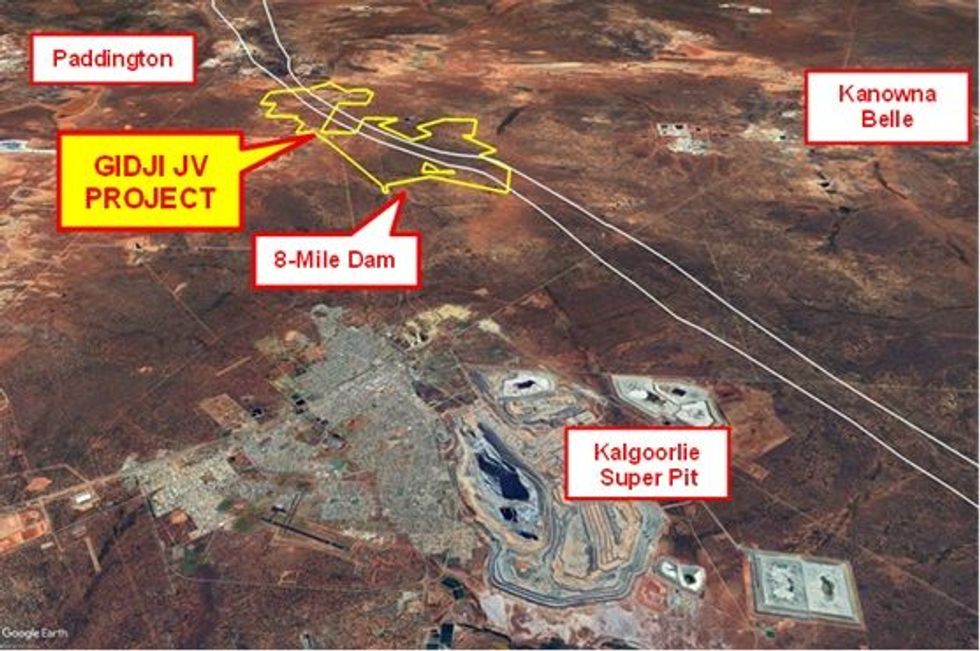
GJRC029 aimed to test an Induced Polarisation (IP) anomaly on the tenement boundary interpreted to represent the sulphide-rich gold mineralisation seen at the neighbouring 8 Mile Dam Deposit.
GJRC029 was collared approximately 10m north of the tenement boundary and mirrored MPGD008, a diamond hole drilled down-dip approximately 40m south of the tenement boundary by KCGM in 2013 and which intersected significant gold mineralisation related to the 8 Mile mafic unit.
Unfortunately, GJRC029 deviated significantly from the planned azimuth and, as a result, by the time the hole was terminated at the target depth of 504m, the drill trace ended up approximately 75m north of the tenement boundary (Figure 2). Despite this, the hole intersected a thick section of the steep westerly- dipping and highly altered 8 Mile mafic unit with widespread sulphide mineralisation, including disseminated magnetite and coarse-grained arsenopyrite, pyrrhotite and chalcopyrite, similar to the 8 Mile Dam Deposit (Figure 3).
Based on visual logging of RC drill chips, handheld portable XRF results and magnetic susceptibility measurements, samples from the bottom 56m of the hole were sent for priority analysis by fire assay at Bureau Veritas in Kalgoorlie.
The results from these initial samples confirm the relationship between the gold mineralisation and sulphides, and a relationship between the best gold mineralisation and coincident magnetic anomalism and elevated Arsenic as measured by handheld portable XRF. The first results also confirm that the IP anomaly is associated with potentially significant gold mineralisation, whilst the significant deviation of GJRC029 away from the planned target increases the potential strike length of gold mineralisation on Miramar’s ground.
Significant results are listed in Table 1, with assay results from the remainder of the hole expected in coming weeks.
The initial RC drilling programme, which also tested two other IP targets, is nearing completion and results will be reported once received and compiled.
Once all assays are received, the Company will plan further RC and/or diamond drill holes including to test the dip and strike extent of the mineralisation intersected in GJRC029.
The Company advises that the WA Department of Mines, Petroleum and Exploration (DMPE) has extended the main Gidji JV tenement, E26/214, for a further five years, and will now expire in March 2030.
Click here for the full ASX Release
This article includes content from Miramar Resources Limited, licensed for the purpose of publishing on Investing News Australia. This article does not constitute financial product advice. It is your responsibility to perform proper due diligence before acting upon any information provided here. Please refer to our full disclaimer here.
Keep reading...Show less
19h
Pacgold
Investor Insight
Pacgold is one of Australia’s most compelling gold exploration opportunities, backed by a strong technical team, offering investors exposure to a large-scale, underexplored gold system with significant resource growth potential.
Overview
Pacgold (ASX:PGO) is an Australian gold exploration company focused on the systematic advancement of the Alice River gold project in Northern Queensland. The company is led by a technically driven and highly experienced team of geologists and mining professionals, with demonstrated success in exploration, resource development and capital markets.
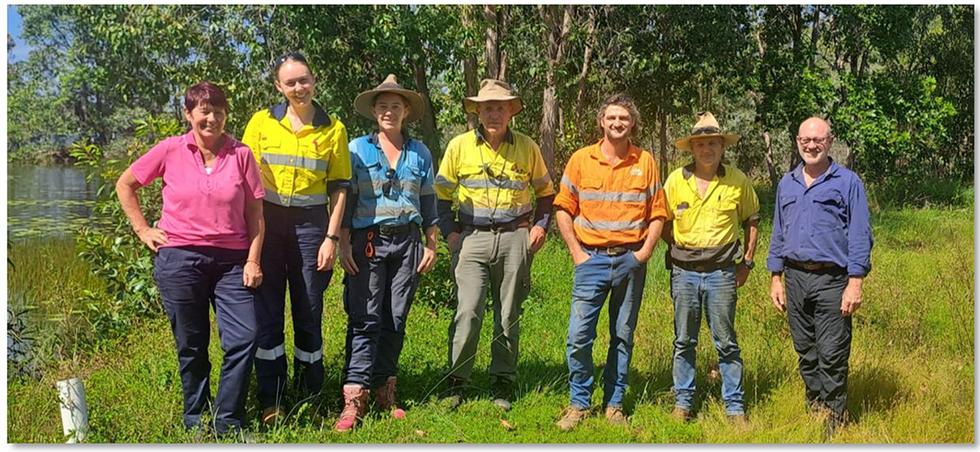
Pacgold team on site at Alice River gold project
With a dominant land position in the region, Pacgold holds 377 sq km of exploration permits and eight mining leases across the prospective Alice River Fault Zone (ARFZ). This structure is interpreted as part of a large-scale intrusion-related gold system, with characteristics analogous to major global deposits such as Fort Knox (USA) and Hemi (Western Australia).
The company has validated its model through drilling success at the Central Zone, culminating in a maiden mineral resource of 474,000 oz of gold. This comprises both open pit and underground components, with resource grades averaging 1.2 grams per ton (g/t) gold, and zones open in all directions. Less than five percent of the strike length has been tested, and much of the prospective corridor is obscured by thin sand cover, highlighting strong potential for blind discoveries.
With extensive infrastructure already in place, including an airstrip, accommodation camp and road access within 100 km, Pacgold is positioned to rapidly scale exploration and accelerate resource growth. The 2025 campaign, which includes more than 10,000 metres of RC drilling and new IP surveys, aims to unlock the full regional potential of the ARFZ.
Company Highlights
- District-scale Discovery Potential: Pacgold controls more than 377 sq km of tenure and more than 30 km of strike length across the Alice River Fault Zone (ARFZ), a fertile, underexplored structural corridor in Northern Queensland.
- Maiden Resource: In May 2025, the company published a 474,000 oz gold mineral resource estimate (MRE), covering just five percent of the total strike, confirming high-grade mineralization and strong potential for expansion.
- Aggressive Exploration Strategy: More than 10,000 metres of RC drilling campaign is underway, complemented by air-core and diamond programs, aimed at growing the Central Zone resource and testing multiple regional targets.
- Attractive Valuation Entry: With a market capitalization of just ~AU$10 million and an EV of AU$8.5 million (as of Q1 2025), Pacgold provides a low-cost entry into a potentially Tier 1 gold system.
- Experienced Leadership: The board includes proven mine developers and discovery geologists with prior success at Chalice, AngloGold Ashanti, BHP and Sibanye-Stillwater.
Key Project
Alice River Gold Project
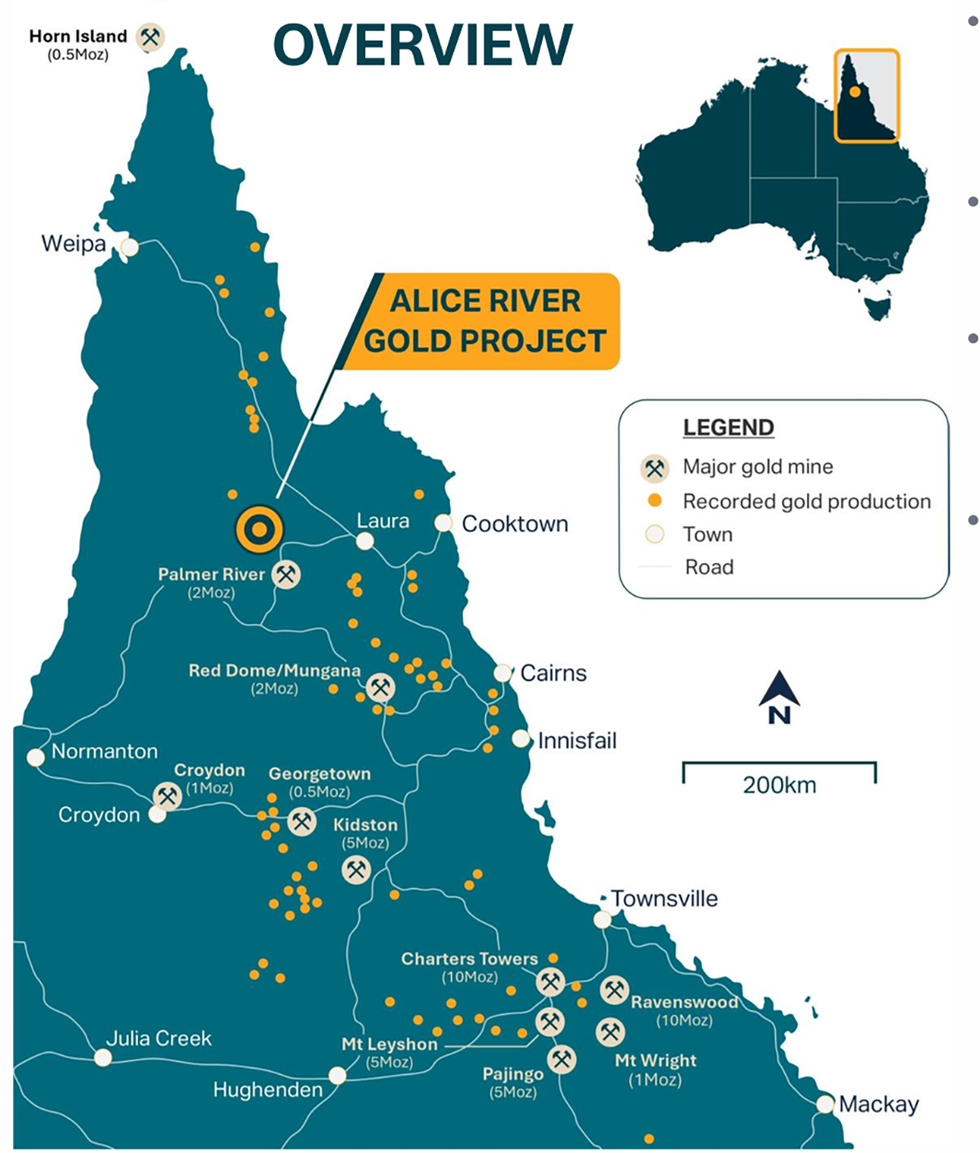
The Alice River gold project is a large-scale, greenstone-hosted gold system centred on the regional ARFZ, located in Northern Queensland. The project area comprises 377 sq km of contiguous tenure, including eight granted mining leases. Pacgold controls over 30 km of strike length along the ARFZ, a major crustal-scale structure that has only recently been systematically explored with modern techniques.
The deposit style is interpreted as an intrusion-related gold system, a highly attractive deposit type known for hosting long-life, large-tonnage gold mines. Examples include the Fort Knox gold mine in Alaska and the Hemi gold project in Western Australia. The Alice River system features sheeted quartz-sulfide veining, extensive sericite-altered zones, and strong IP chargeability responses coincident with surface gold anomalism.
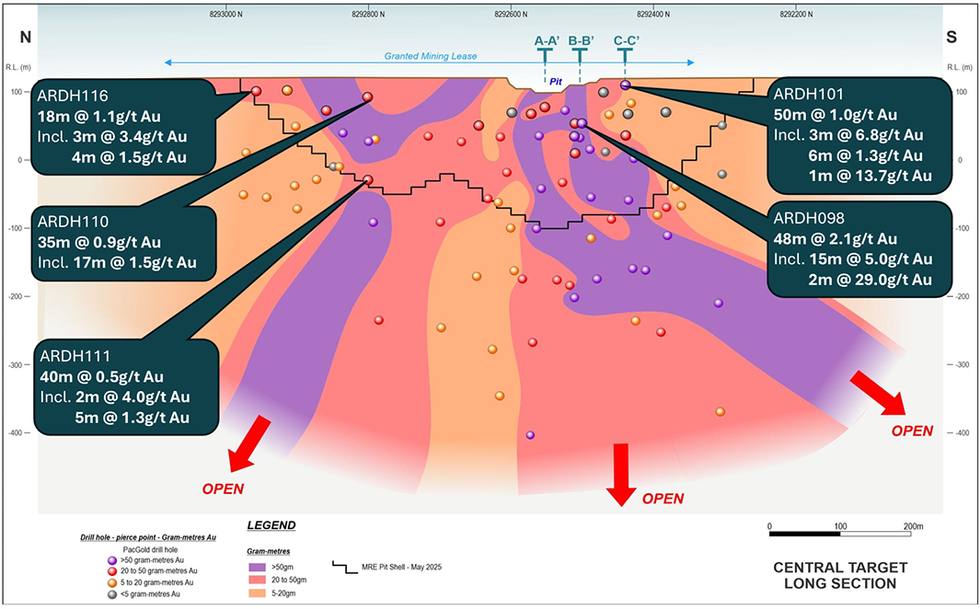
Pacgold’s 2024 and 2025 drilling campaigns have focused on the Central Zone, which yielded the maiden MRE totaling 474,000 oz gold across both open pit and underground resources. The pit-constrained resource includes 10.6 Mt at 1.2 g/t gold (404,000 oz), with a further 1.5 Mt at 1.4 g/t gold (71,000 oz) defined for underground potential. High-grade zones remain open at depth and laterally, with drill spacing still relatively broad (~80 x 80 metres), leaving significant scope for resource expansion.
Beyond the Central Zone, the company has delineated multiple high-priority regional targets along the ARFZ. These include:
- White Lion: A compelling target with surface gold anomalism and a coincident IP chargeability anomaly. A gradient and dipole-dipole IP survey is being extended in Q2 2025, with drilling expected in Q4.
- Victoria and The Shadows: Emerging prospects to the south with limited historical drilling but strong geophysical responses.
- Posie and Southern Target Area: Additional areas along the southern ARFZ strike that exhibit strong structural preparation, geochemical responses and potential for concealed mineralization.
Drilling recommenced in April 2025, with RC drilling underway and air-core and diamond drilling scheduled through Q3 2025. The program aims to increase drill density in resource zones and test underexplored regional anomalies. Pacgold expects up to 15,000 metres of total drilling during the 2025 campaign, coupled with ongoing geophysical targeting, including IP and drone magnetics.
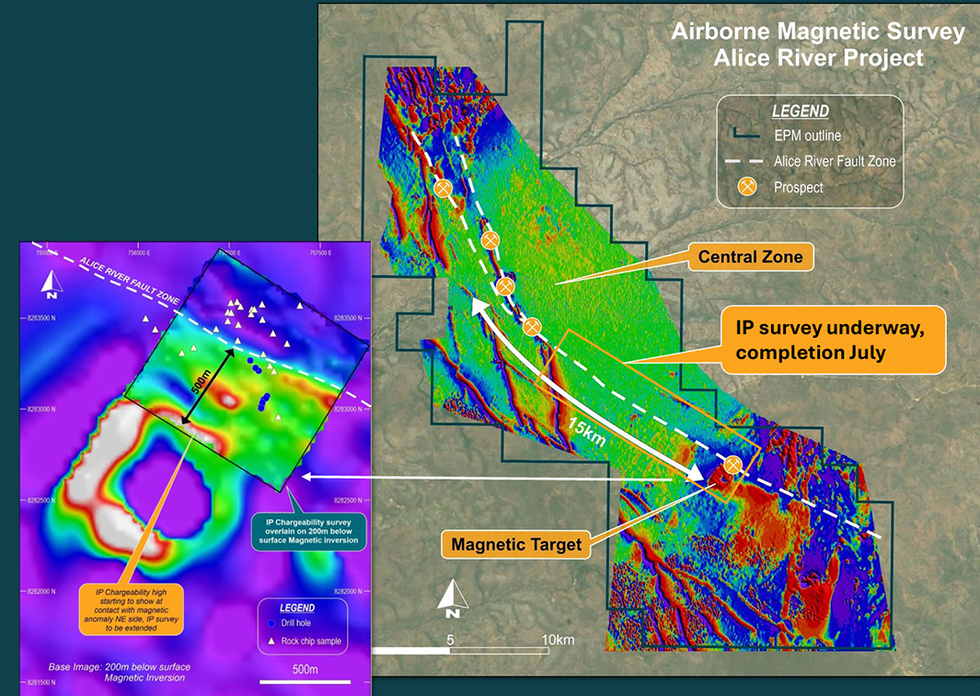
The project is fully permitted, with strong access and logistics, and is located in a low-risk jurisdiction with significant precedent for gold development. With limited historical exploration and clear mineralizing controls now defined, Alice River represents a transformative opportunity to uncover a Tier 1 discovery in an overlooked Australian belt.
Management Team
Matthew Boyes – Managing Director and CEO
Matthew Boyes is a geologist with over 28 years of international experience across mine geology, exploration, corporate leadership and capital markets. He has managed exploration teams and development projects across Western Australia, the Americas and Europe. His technical oversight and commercial strategy guide Pacgold’s resource growth and investor engagement.
Caoilin Chestnutt – Non-executive Chair
A former head of business development at BHP and currently head of technical services at Thiess, Caoilin Chestnutt brings nearly 30 years of experience in global exploration strategy, M&A and deal structuring across multiple commodities. She is also deputy chair of Critical Minerals at the Queensland Exploration Council.
Michael Pitt – Non-executive Director
Michael Pitt is the co-founder of New Century Resources (ASX:NCZ), and former VP of business development at Sibanye-Stillwater (JSE:SSW). He currently leads development at Broken Hill Mines. His expertise in mine redevelopment and business strategy supports Pacgold’s long-term operational execution.
Richard Hacker – Non-executive Director
Former CFO and GM commercial at Chalice Mining (ASX:CHN), Richard Hacker played a key role in the Julimar discovery. He has held leadership roles at Liontown Resources and DevEx. Hacker contributes deep experience in financial oversight and strategic planning for discovery-stage companies.
Bruce Kendall – Non-executive Director
Bruce Kendall is an award-winning exploration geologist with over 30 years in exploration management at AngloGold Ashanti, Chalice Mining, Jabiru Metals and IGO. He was a key contributor to the Tropicana, Julimar and Coyote discoveries, and brings essential geological insight to Pacgold’s targeting and evaluation.
Geoff Lowe – Exploration Manager
As a Competent Person and seasoned exploration geologist, Geoff Lowe is responsible for executing Pacgold’s field campaigns. He has played a central role in resource modeling, target generation and drill program design for the Alice River project.
Keep reading...Show less
21h
WGC: Gold Keeps Climbing, Future Hinges on Economic and Geopolitical Crossroads
Gold has notched an extraordinary first half of 2025, climbing 26 percent in US dollar terms and setting 26 new all-time highs — but the rally now faces a murky and fragile second act shaped by inflation, monetary policy, and unresolved global tensions, according to the World Gold Council’s (WGC) recent mid-year report.
Investors around the globe turned to gold as both a tactical hedge and a strategic store of value, pushing trading volumes to an all-time high of US$329 billion per day in the first six months of the year.
The WGC’s mid-year outlook suggests the precious metal’s momentum could continue, but with significant caveats. Under current consensus forecasts, gold is likely to remain rangebound in the second half, potentially rising another 0 to 5 percent.
However, sharp deviations in macro conditions — particularly those involving stagflation, recession, or worsening geopolitical risks — could lift gold by an additional 10 percent to 15 percent before year-end.
A record-breaking first half
Gold’s 26 percent gain in H1 made it one of 2025’s top-performing major assets. The yellow metal benefited from a rare combination of global factors: a declining US dollar — which had its worst start to a year since 1973 — muted Treasury yields, and a sharp uptick in geopolitical tensions, many linked to US trade policies and regional flashpoints.
These factors created fertile ground for strong inflows into exchange-traded funds (ETFs), over-the-counter (OTC) markets, and futures.
Gold ETF holdings surged by 397 metric tons in the first half — the highest since August 2022 — bringing total holdings to 3,616 tonnes and pushing total assets under management to $383 billion, a 41 percent increase from the start of the year.
Central banks, too, continued to buy gold, albeit at a moderated pace compared to the record-setting quarters of 2022 and 2023. Although net purchases have slowed, they remain significantly above the pre-2022 average of 500–600 metric tons annually.
Why investors piled in
According to the WGC’s Gold Return Attribution Model (GRAM), three key drivers contributed to gold’s H1 surge: risk and uncertainty, opportunity cost, and momentum.
Investor demand stemming from heightened geopolitical and financial risks contributed approximately 4 percent of gold’s return, with half of that explained by a measurable increase in the Geopolitical Risk Index.
A further 7 percent of the return was attributed to changes in opportunity cost, primarily due to the weakening dollar and low bond yields, which made non-interest-bearing gold relatively more attractive.
Lastly, momentum effects, including continued ETF inflows and trend-following investment behavior, added another 5 percent, supporting the metal’s climb through positive feedback loops.
Altogether, these macro and market-based dynamics explained around 16 percentage points of gold’s 26 percent performance in the first six months of the year.
The outlook: Three scenarios for H2
While gold’s fundamentals remain supportive, analysts are cautious about expecting a repeat performance in H2. The WGC outlines three macroeconomic paths that could shape gold’s direction in the second half.
In the base case, moderate global growth and inflation settling near 5 percent could keep real yields subdued, especially if the US Federal Reserve cuts rates by 50 basis points in the fourth quarter.
This environment would likely support gold prices modestly, with forecasts pointing to gains of up to 5 percent. Continued interest from ETF and OTC investors could offset softer consumer demand and increased recycling, both of which may act as speed bumps for further upside.
The bull case envisions a sharp rise in gold if economic conditions worsen — either through stagflation or a full-blown recession.
A flight to safety could trigger renewed ETF inflows, central bank diversification away from the dollar, and heavier positioning in COMEX futures. Under this stress-driven rally, gold could surge another 10 to 15 percent in H2, echoing the strong performance seen during previous crises like 2008 and the early pandemic years.
On the flip side, a more stable geopolitical and macroeconomic environment, such as a resolution to major global conflicts or normalization in trade, would dampen demand for gold. In this bear case, stronger yields and renewed investor appetite for risk assets could pull gold down by as much as 12 to 17 percent.
No matter the outcome, gold continues to serve as a resilient portfolio hedge. Its strong showing in the first half of 2025 reaffirmed its utility in volatile markets, particularly as traditional safe havens like US Treasuries struggle to deliver.
Even if jewelry and retail demand sees pressure, structural support could come from institutional players — including reports that Chinese insurers are quietly upping their gold allocations.
For now, gold may consolidate. But should conditions turn, the metal still has plenty of room to move, in either direction.
Don’t forget to follow us @INN_Resource for real-time updates!
Securities Disclosure: I, Giann Liguid, hold no direct investment interest in any company mentioned in this article.
Keep reading...Show less
16 July
Wide Gold Intercepts at Mt York Support Future Resource Growth
Three diamond drill rigs on site at 1.4Moz Mt York Gold Project, WA, with 56% of Stage 1 resource drilling complete; Results extend mineralisation along strike and at depth; good continuity of higher-grade shoots confirms new structural model
Kairos Minerals Ltd (ASX:KAI) (“KAI” or the “Company”) is pleased to announce results from the first 16 diamond holes drilled at its Mt York Gold Project in WA’s Pilbara, where current resources at the Main Trend sit at 1.4Moz Au. The results are from Gossan Hill (7 holes), Breccia Hill (5 holes) and Main Hill (4 holes) (Table 1), and are shown on drill plan (Figure 1) and long-section (Figure 2).
Highlights
- 36 holes for 10,025m completed at Mt York, ahead of schedule and on-budget; Stage 1 is an 80-hole, 18,000m resource expansion program
- Results for 16 holes received, with best intercepts including:
- 21m @ 1.87 g/t Au from 169m incl 9m @ 3.19 g/t Au (25MYDD009);
- 5m @ 4.26 g/t Au from 299m (25MYDD010);
- 34m @ 0.81 g/t Au from 242m incl 7m @ 2.66 g/t Au from 269m (25MYDD012);
- 24m @ 1.17 g/t Au from 222m incl 7m @ 2.62 g/t Au from 222m (25MYDD016);
- 48m @ 1.03 g/t Au from 227m incl 11m @ 3.38 g/t Au from 264m (25MYDD017).
- Higher-grade mineralisation consistently reported across Main Trend confirming and extending high-grade shoots at all prospects
- Encouraging first results likely to positively impact grades and widths of mineralisation for an updated resource estimate later in 2025
- Drilling accelerated with third diamond drill rig capable of low-angle drilling on site at the highly prospective but under-drilled Main Hill Prospect
Stage 1 drilling aims to boost gold resources at Mt York and test extensions of high- grade shoots ahead of a mineral resource estimate (MRE) update expected in 2H CY25. Stage 2 drilling later in the year or early 2026 aims to convert Inferred resources to higher confidence Indicated resources.
Kairos Managing Director Dr Peter Turner said: “The first results from Mt York continue to reinforce our belief in the potential scale of this project, and we are on track to deliver a new and much improved mineral resource estimate later in 2025 incorporating at least 18,000m of additional drilling results. We continue to ask ourselves ‘how big is the Mt York gold resource’ and will increase and expand Stage 1 drilling if we believe the mineralisation continues to be open which appears to be the case at the moment.
We are seeing good widths of mineralisation in areas where the resource model is unguided and importantly, solid higher-grade gold intercepts within the lower-grade envelopes. From the previous 2023 resource, Mt York has more than 750,000 ounces of gold at 1.6 g/t Au and the current drilling is confirming that high-grade shoots are both horizontal within the system, but also likely to be extensive (>300m) along-strike in both footwall and hangingwall positions. This is great news.
We are drilling the western half of the large Main Hill Prospect where the mineralised banded iron formation (BIF) host rocks attain 100m in true thickness but where topographic challenges previously prevented drilling. With a suitable small-footprint rig now in place, we can see an assemblage of sulphide-bearing BIF in many drill holes in this area that is associated with free-milling gold mineralisation in other parts of the Main Trend.
With drilling scheduled to continue into September and possibly beyond, we look forward to releasing results as they become available.
We are confident Mt York will become one of the Pilbara’s (and Western Australia’s) largest undeveloped gold resources with clean metallurgy once drilling is complete.”
Drill Results
Results from the first 16 holes are shown in Table 1. The Stage 1 drill holes have been designed to test the grades and widths of mineralisation and purposely looking for extensions of higher-grade pods within the entire 3,000m-long Main Trend Gold Deposit. The positions of the drill holes and their results are shown on Figure 1 (plan view) & Figure 2 (long-section).
Holes 25MYDD007 to 25MYDD009 test gaps in the resource model at Breccia Hill and confirm multiple zones of mineralisation, where 25MYDD009 returned high-grade core of 9m @ 3.19 g/t Au from 176m. This confirms the extension of a high-grade pod of mineralisation some 75m away from historic drillhole KMYD040’s result of 10m @ 4.90 g/t Au from 257m1, that confirms that higher-grade mineralisation may well form significant, horizontal zones previously not recognised yet confirmed in recent structural interpretation.
Deeper drilling into the eastern side of Main Hill has infilled and extended mineralisation with holes 25MYDD010, 012, 014 and 017. Big gains in both mineralisation width and grade are captured in hole 25MYDD017 that intercepted multiple zones including 48m @ 1.03 g/t Au from 227m including a higher-grade zone of 11m @ 3.38 g/t Au from 264m. This extends a new zone of high-grade mineralisation on the footwall position and forms part of the horizontal-plunging, high-grade zone drilled >300m to the west in hole 25MYDD012 (7m @ 2.66 g/t Au from 269m) extending to 25MYDD010 (5m @ 4.26 g/t Au from 299m) (see Figure 2). Another 5 drillholes are planned to the west of these holes to test the extension of the high-grade mineralisation for a further 500m to the west (Figure 1).
The results of the mineralised intercepts are considered close to true widths as the mineralisation has been intercepted orthogonally.
A third diamond drill rig (DDH1 drill rig #83) capable of low-angle drilling has been sent to site to accelerate the program, especially at the poorly tested but prospective Main Hill Prospect. Historic drill results of 109m @ 2.09 g/t Au from 50m (MYD24A) entirely in banded iron formation (BIF) host rocks demonstrate the importance of this prospect. The mineralised banded iron formation (BIF) rocks are the thickest (~100m true thickness) in the area but due to the topographic and access challenges around the hill, the Main Hill target has, until now, been inaccessible for drill rigs.
Holes 25MYDD001-006 are largely testing the mineralised banded iron formation (BIF) on the extreme eastern end of the Main Trend at Gossan Hill.
Rig #83 is drilling the Main Hill Prospect extensively from both the northern and southern sides of the hill (see Photo 2) to truly understand the scale of the resource in this area. There is plenty of evidence that high-grade mineralisation exists at this prospect. Results for these holes (25MYDD023, 028, 031, 032, 033, 034 – see Figure 1 and 2 for location of holes) are awaited.
Further drill results are expected throughout July, August and September and will be released to the ASX once routine quality-assurance, quality-control (QAQC) checks have been completed.
Click here for the full ASX Release
This article includes content from Kairos Minerals, licensed for the purpose of publishing on Investing News Australia. This article does not constitute financial product advice. It is your responsibility to perform proper due diligence before acting upon any information provided here. Please refer to our full disclaimer here.
Keep reading...Show less
16 July
Drilling Commences at Leonora South Gold Targets
Latest News

Sign up to get your FREE
Kalgoorlie Gold Mining Investor Kit
and hear about exciting investment opportunities.
- Corporate info
- Insights
- Growth strategies
- Upcoming projects
GET YOUR FREE INVESTOR KIT
Latest Press Releases
Related News
TOP STOCKS
American Battery4.030.24
Aion Therapeutic0.10-0.01
Cybin Corp2.140.00
